For 2024, the best backup cameras offer you safety and peace of mind. You can't go wrong with models like the HD 1080P Backup Camera with a 170-degree wide view angle, or the NATIKA Waterproof Camera, known for its durability. The eRapta ERT01 provides solid performance and user-friendly installation. Additionally, consider features like night vision and waterproof ratings to guarantee reliability. These cameras enhance visibility, making reversing safer than ever. Want to make the best choice? You're just a step away from discovering which model fits your needs perfectly.
Backup Camera HD 1080P with Monitor for Cars and Trucks
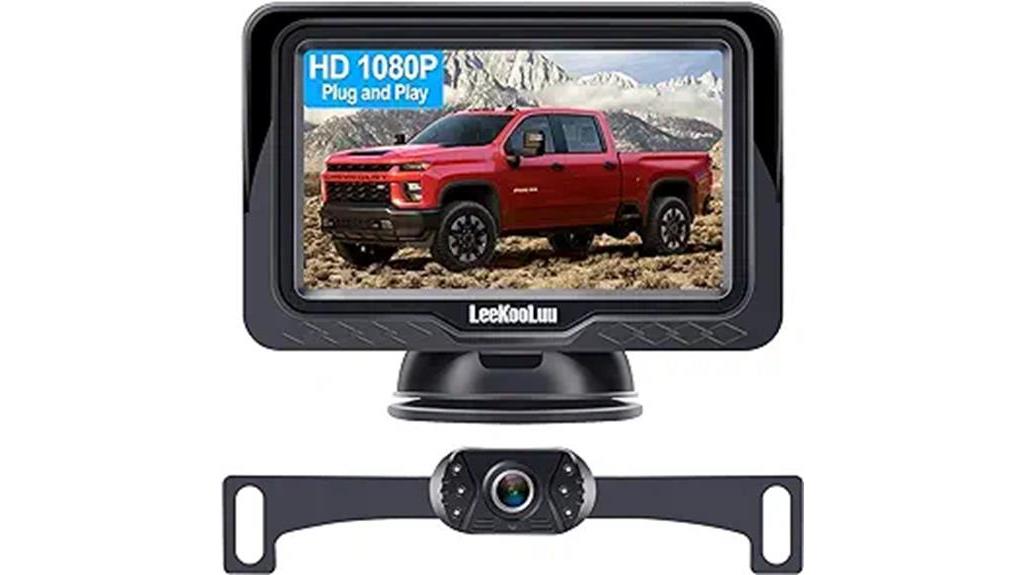
If you're looking for a reliable backup camera that delivers HD 1080P quality, the Backup Camera Easy Setup Plug-Play by LeeKooLuu is an excellent choice for both cars and trucks. Installation is a breeze; it takes about 15 minutes with just a simple plug-and-play setup. I love how versatile it is, fitting various vehicles, from SUVs to trailers. The image quality is impressive, with stable transmission and no delays, even in low light thanks to the night vision feature. Plus, its waterproof design means it's ready for any weather. With a 2-year warranty and lifetime support, I feel confident in my purchase. This camera truly enhances safety and peace of mind while reversing.
Best For: Drivers of cars, trucks, SUVs, and trailers who want an easy-to-install, high-quality backup camera for enhanced safety while reversing.
Pros:
- Easy plug-and-play installation that takes approximately 15 minutes.
- High-definition 1080P image quality with stable signal transmission and effective night vision.
- Waterproof design with a wide operational temperature range, ensuring durability in various weather conditions.
Cons:
- Some users may find the wiring setup challenging if unfamiliar with vehicle electronics.
- Limited adjustment options for camera placement may not suit every vehicle model perfectly.
- Night vision quality may vary depending on extreme low-light conditions.
HD Backup Camera with 170 Degree Wide View Angle
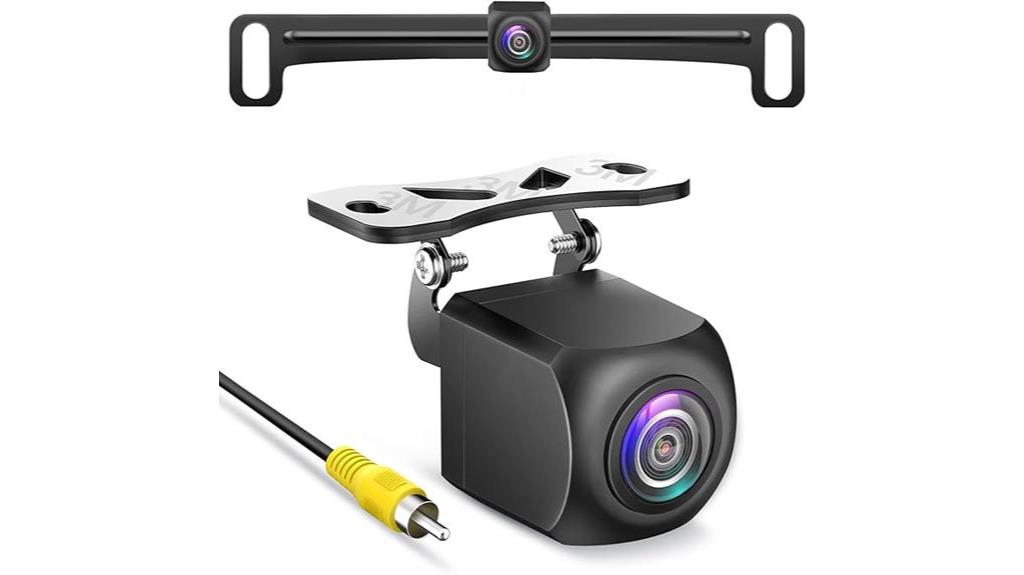
The HD Backup Camera with a 170-degree wide view angle is an ideal choice for anyone seeking enhanced safety and visibility while reversing. With its metal housing and IP69 waterproof rating, this camera promises durability and reliability. I love how the 1/2.7 inch large sensor chip delivers clear images in both bright and dark conditions, thanks to its advanced noise reduction features. Installation is straightforward, as it comes with two brackets and all necessary tools. Plus, the positive user feedback highlights its excellent video clarity. With a solid customer rating of 4.5 stars and backed by a three-year support warranty, I feel confident recommending this backup camera for anyone wanting peace of mind on the road.
Best For: Those seeking a reliable and high-quality backup camera for enhanced visibility and safety while reversing.
Pros:
- Durable metal housing with an IP69 waterproof rating ensures longevity and resilience.
- 170-degree wide view angle provides extensive visibility, reducing blind spots when reversing.
- Easy installation with included brackets and tools, along with positive user feedback on video clarity.
Cons:
- Limited compatibility only with car screens featuring RCA connectors, excluding dash cams and GPS systems.
- Weight (8.1 ounces) may be heavier than some plastic alternatives, potentially affecting installation.
- Requires professional installation for users unfamiliar with vehicle wiring, which could incur additional costs.
NATIKA Backup/Front View Camera (IP69K Waterproof, HD)
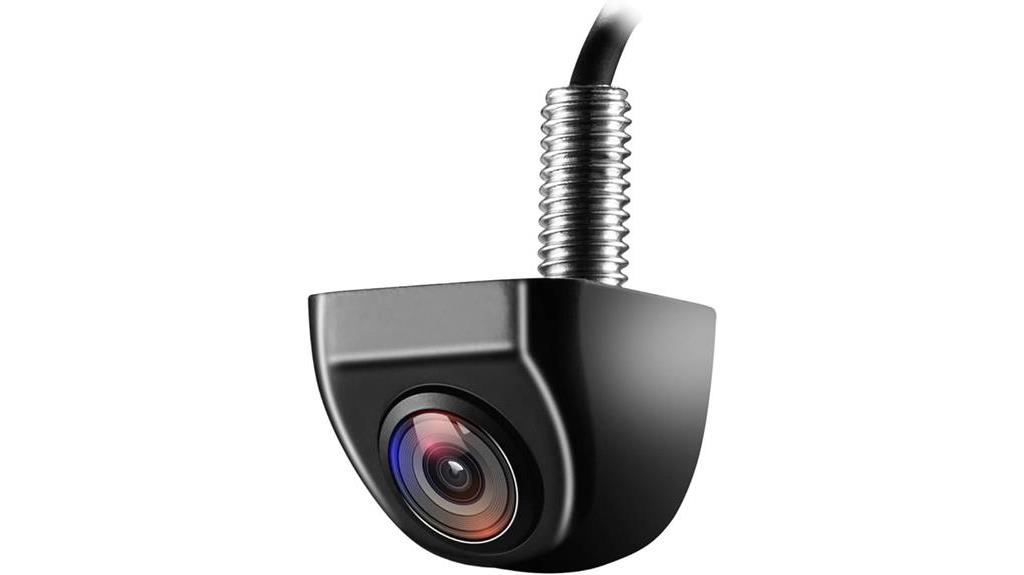
Looking for a reliable backup camera that excels in tough conditions? The NATIKA Backup/Front View Camera is an excellent choice. With its IP69K waterproof rating, it's designed to withstand heavy rain and moisture, ensuring durability. The HD 600TVL image sensor provides a 170-degree viewing angle, giving you a clear view of blind spots. I appreciate its compact, OEM-style design, which fits seamlessly into my vehicle.
Installation can be a bit tricky, especially when connecting wires, but it's worth it for the performance. Night vision is decent, although some users note slight graininess. Plus, with a 30-day money-back guarantee and a 24-month replacement warranty, you can feel confident in your purchase. Overall, it's a solid option for anyone seeking a dependable backup camera.
Best For: Those seeking a reliable and durable backup camera for vehicles in various weather conditions.
Pros:
- IP69K waterproof rating ensures protection against heavy rain and moisture.
- 170-degree viewing angle enhances visibility of blind spots for safer maneuvers.
- 30-day money-back guarantee and a 24-month replacement warranty provide peace of mind with the purchase.
Cons:
- Installation can be challenging, particularly with wire connections.
- Some users report graininess in night vision performance.
- Additional sealing may be needed at cable connections to prevent moisture issues.
eRapta ERT01 HD Backup Camera for Vehicles
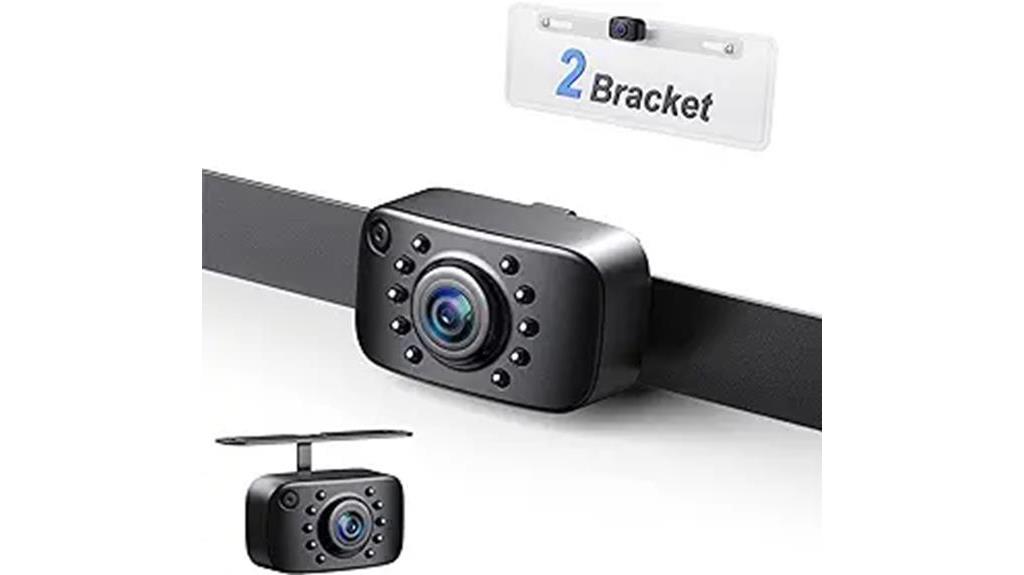
For anyone seeking a reliable and high-quality backup camera, the eRapta ERT01 HD is often the best choice, especially for those who drive larger vehicles like SUVs or pickup trucks. This wired rear view camera offers a 149-degree wide viewing angle and 720P resolution, ensuring you see everything behind you clearly. I appreciate its durability, boasting an IP69K waterproof rating, which means it holds up well in various weather conditions. Installation is straightforward with included accessories, and it connects easily to any display with RCA inputs. While some users have noted calibration issues, the overall performance is solid, especially at night thanks to its 10 LED lights. Plus, the two-year warranty adds peace of mind.
Best For: Those seeking a reliable backup camera for larger vehicles like SUVs or pickup trucks that offers durability and ease of installation.
Pros:
- Excellent 149-degree wide viewing angle for enhanced visibility.
- IP69K waterproof rating ensures durability in various weather conditions.
- Easy installation with included accessories and compatibility with RCA inputs.
Cons:
- Some users experience calibration issues affecting image quality.
- Installation manual may lack clarity due to poor translation.
- Fixed camera angle can limit adjustments over time.
eRapta Backup Camera for Truck with 2K Front Rear View Monitor
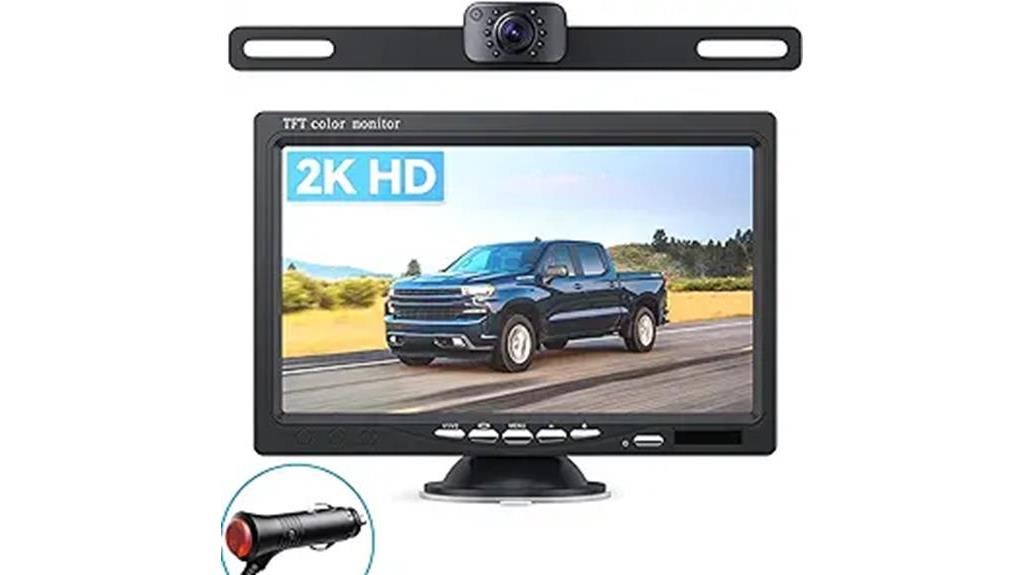
If you're searching for a reliable backup camera that combines high-quality visuals with ease of installation, the eRapta Backup Camera for Truck with its 2K Front Rear View Monitor stands out. This system features a 7-inch high-resolution screen and a powerful camera, ensuring crisp images, even in low light thanks to its night vision capabilities. Installation is a breeze, powered through a car charger, and the monitor easily mounts on your windshield or desk. With an IP69K waterproof rating, it's built to endure tough conditions. Plus, the adjustable settings let you optimize brightness and contrast for clear viewing. With excellent customer feedback and a two-year warranty, it's a fantastic choice for anyone looking for safety and reliability on the road.
Best For: Those seeking an affordable, high-quality backup camera with easy installation and robust support for enhanced safety while driving.
Pros:
- High-resolution 2K image quality for clear visuals in various lighting conditions.
- Easy installation process with plug-and-play features and flexible mounting options.
- Durable design with an IP69K waterproof rating, ensuring reliability in tough weather conditions.
Cons:
- Lack of fisheye lens may make close backing more challenging for some users.
- Wiring harness issues reported by a few customers, although support addressed them promptly.
- Adjustable settings may require some time to optimize for individual preferences.
Factors to Consider When Choosing Backup Cameras
When choosing a backup camera, you should prioritize image quality, as it directly affects your ability to see obstacles clearly. Don't overlook installation ease, because a complicated setup can lead to frustration. Additionally, consider factors like viewing angle, waterproof rating, and night vision capabilities to guarantee you have a reliable system for all conditions.
Image Quality Importance
Choosing a backup camera means prioritizing image quality, as it directly affects your safety while reversing. High-definition resolutions like 1080P and 720P offer clearer visuals, making it easier to spot obstacles and pedestrians. When you're backing up, you want every detail to be sharp, so look for cameras with higher resolution sensors, such as 1/2.7-inch chips, to enhance image clarity.
Night vision capabilities are another critical factor. Cameras equipped with built-in LEDs can greatly improve visibility during low-light conditions, ensuring you don't miss anything in the dark. Additionally, a wide viewing angle, typically around 170 degrees, gives you a broader field of vision, reducing blind spots and increasing overall safety.
Lastly, consider the construction and durability of the camera. Features like waterproof ratings, such as IP69K, help maintain image quality despite environmental challenges. When you choose a backup camera, remember that high-quality visuals are essential for safe maneuvering, especially in tricky situations. Prioritizing these factors will give you peace of mind while you drive.
Installation Ease
Installing a backup camera can be a straightforward process, especially when you choose models designed for easy setup. Look for backup cameras that offer plug-and-play installation; many can be completed in about 15 minutes without needing extensive wiring knowledge. This means less hassle and more time enjoying the benefits of your new camera.
Check for included mounting options like suction cups or adjustable brackets, as these can simplify positioning the camera on your vehicle. A well-placed camera is essential for peak performance. Verify the camera kit includes sufficient wiring and connectors to facilitate easier routing and connections to your vehicle's power source. This way, you won't have to hunt for additional materials, saving you time and effort.
Consider products that come with installation accessories and tools; this can enhance the installation experience and reduce the need for extra purchases. Finally, read user reviews to gauge common experiences regarding installation ease. Many users share insights on how straightforward or challenging the process was, helping you make an informed choice. By prioritizing these factors, you can enjoy a smooth installation and get right to using your backup camera.
Viewing Angle Considerations
After you've tackled the installation of your backup camera, the next important aspect to evaluate is the viewing angle. A wide viewing angle, typically around 170 degrees, provides better visibility of blind spots and greatly reduces the risk of accidents when reversing or parking. This is essential for enhancing your safety on the road.
If you have specific needs, consider cameras with adjustable viewing angles. This flexibility allows you to tailor the field of vision to suit your vehicle and driving preferences. While a fisheye lens can offer a panoramic view, be cautious—it may distort the image, making objects appear closer than they are, which can mislead your depth perception.
When choosing a camera, aim for an ideal viewing angle that balances a thorough field of view with clear image resolution, especially at the edges. Additionally, look for models that allow for customizable parking grid lines. These grid lines can enhance your spatial awareness and assist you in precise maneuvering, making it easier to navigate tight spaces without stress.
Waterproof Rating
When selecting a backup camera, the waterproof rating is a crucial factor that can markedly impact its performance and longevity. You'll often encounter ratings like IP67, IP68, or IP69K, which indicate how well the camera can resist water exposure and moisture. An IP69K rating stands out, as it means the camera is dustproof and can handle high-pressure water jets from any direction, making it ideal for extreme weather conditions.
On the other hand, cameras with lower ratings, such as IP67, can only survive immersion in water up to 1 meter for 30 minutes. This might not be adequate for all environments, especially if you frequently drive in rainy or wet conditions. By opting for a backup camera with a higher waterproof rating, you guarantee greater durability and functionality, regardless of the weather.
Additionally, many high-quality backup cameras are designed to work effectively in temperatures ranging from -22°F to 176°F, enhancing their reliability across diverse climates. So, when making your choice, don't overlook the waterproof rating; it's crucial for maintaining your camera's performance over time.
Night Vision Capabilities
Considering night vision capabilities is essential for ensuring safety during nighttime driving. When you're reversing in low-light conditions, a backup camera with built-in LED lights can greatly enhance visibility, illuminating the area behind your vehicle. Look for models with a low illumination level rating, such as 0.01 Lux, which can capture detailed images even in near darkness. This feature is vital for avoiding obstacles and ensuring safety.
Advanced sensors in backup cameras can also improve image quality at night, reducing graininess and enhancing clarity. However, effectiveness varies between models, so it's important to check customer reviews and performance ratings to find one that meets your needs.
Additionally, consider a waterproof rating like IP69K. A sealed unit is less likely to fog up or let moisture in, which can drastically impair visibility during adverse weather conditions. By prioritizing night vision capabilities, you're investing in a backup camera that not only helps you navigate safely in the dark but also provides peace of mind every time you hit the road. Choose wisely, and you'll enhance your nighttime driving experience greatly.
Compatibility With Vehicles
Choosing the right backup camera for your vehicle hinges on compatibility factors that can make or break your driving experience. First, confirm the camera meets your vehicle's power requirements, typically operating between 12-24V DC. This is vital for functionality and longevity.
Next, check if the camera can connect to your existing display system. Some models require RCA video inputs, while others may integrate wirelessly. Be certain to align your selection with your vehicle's specifications.
Look for backup cameras that offer universal fit options. This way, you can find a model suitable for various vehicles, including cars, trucks, SUVs, and vans. Adjustable mounting options are equally important, as they facilitate installation regardless of your vehicle's type or configuration.
Lastly, consider cameras that support features like front/rear view switching. This can greatly enhance usability, allowing you to adapt the camera's functionality to your specific needs. By paying attention to these compatibility factors, you can guarantee a seamless integration of your backup camera, leading to a safer driving experience.
Warranty and Support
Warranty and support can make all the difference in your backup camera experience. When you're choosing a backup camera, pay close attention to the warranty duration. A longer warranty, like 2 to 3 years, often reflects the manufacturer's confidence in their product's durability and reliability. You'd want to feel secure in your investment, after all.
Additionally, look for cameras that offer a money-back guarantee, usually within 30 days. This allows you to test the product without any risk. If something doesn't meet your expectations, you can return it hassle-free.
Don't overlook the value of lifetime technical support. This can be essential for troubleshooting or assistance during installation and use. Investigate customer feedback as well; it'll give you insights into how responsive and effective the manufacturer's customer service is, especially regarding warranty claims.
Some backup cameras even come with replacement guarantees that can last up to 36 months, providing you with extra peace of mind against defects or issues. By considering these warranty and support factors, you can make a well-informed choice that enhances your backup camera experience.
Frequently Asked Questions
Are Backup Cameras Legal to Install in My Vehicle?
Yes, backup cameras are generally legal to install in your vehicle, and they can enhance your safety while reversing. Most states encourage their use due to the added visibility they provide. However, you should check local regulations to verify compliance, as laws can vary. Installing a backup camera not only improves your awareness but can also help prevent accidents, making it a smart investment for your driving experience.
How Do I Maintain My Backup Camera for Longevity?
To maintain your backup camera for longevity, regularly clean the lens with a soft cloth to remove dirt and grime that can obstruct the view. Check the connections and wiring periodically to prevent any loose or damaged parts. If your camera has a protective cover, verify it's intact and functioning. Avoid exposing the camera to extreme temperatures or harsh weather conditions, as these can affect performance. Regular maintenance helps keep your backup camera in top shape.
Can I Use a Backup Camera in Bad Weather Conditions?
Yes, you can use a backup camera in bad weather conditions, but its effectiveness may vary. Rain, fog, or snow can obstruct the camera lens or reduce visibility. To improve performance, make certain the camera's lens is clean and free of obstructions. Many modern backup cameras come with features like night vision and enhanced weather resistance, so check your model's specifications. Always remember to drive cautiously in adverse weather, regardless of camera capabilities.
Will a Backup Camera Work With My Vehicle's Existing Display?
Yes, a backup camera can work with your vehicle's existing display, but it depends on compatibility. Most newer vehicles have built-in systems designed to integrate with backup cameras, allowing seamless functionality. However, if your vehicle is older, you might need an adapter or a new display unit. Always check the specifications of both the camera and your vehicle's display to guarantee they're compatible before making a purchase.
How Do I Troubleshoot Issues With My Backup Camera?
If you're having issues with your backup camera, start by checking the power source. Confirm the camera's wiring is securely connected and not damaged. Next, inspect the display settings on your vehicle to verify the camera's feed is activated. Clean the camera lens to eliminate any obstructions affecting visibility. If problems persist, consult the user manual for troubleshooting steps or consider seeking professional help to diagnose the issue accurately.
Wrapping Up
So, if you're still backing up without a camera, you might as well drive blindfolded! With these top backup cameras of 2024, you can finally ditch the old-school method of twisting your neck like a pretzel. Investing in one of these devices not only saves you from potential fender-benders but also keeps your car looking less like a bumper car arena. Don't leave your safety to chance—grab a backup camera and reclaim your peace of mind!
Ben Wilkinson is a an experienced mechanic with over 10 years of experience in the automotive repair industry. He is highly skilled in diagnosing and repairing a wide range of car-related issues, from basic maintenance tasks to more complex repairs.

